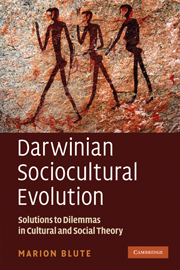Book contents
- Frontmatter
- Contents
- Preface: a postmodern metanarrative
- Acknowledgments
- 1 Introduction
- 2 History: where did something come from?
- 3 Necessity: why did it evolve?
- 4 Competition, conflict and cooperation: why and how do they interact socially?
- 5 The ideal and the material: the role of memes in evolutionary social science
- 6 Micro and macro I: the problem of agency
- 7 Micro and macro II: the problem of subjectivity
- 8 Micro and macro III: the evolution of complexity and the problem of social structure
- 9 Evolutionism and the future of the social sciences
- References
- Index
2 - History: where did something come from?
Published online by Cambridge University Press: 05 June 2012
- Frontmatter
- Contents
- Preface: a postmodern metanarrative
- Acknowledgments
- 1 Introduction
- 2 History: where did something come from?
- 3 Necessity: why did it evolve?
- 4 Competition, conflict and cooperation: why and how do they interact socially?
- 5 The ideal and the material: the role of memes in evolutionary social science
- 6 Micro and macro I: the problem of agency
- 7 Micro and macro II: the problem of subjectivity
- 8 Micro and macro III: the evolution of complexity and the problem of social structure
- 9 Evolutionism and the future of the social sciences
- References
- Index
Summary
DARWIN'S TREE “I THINK”
“Darwin: The Evolution Revolution”, a museum exhibit mounted by the American Museum of Natural History in New York, recently spent time in my home city, Toronto. It included a facsimile of Darwin's Notebook B, the first on transmutation of species – open at page 36 and also available online (van Wyhe 2002–9). The page includes Darwin's initial sketch of a diagram that was the only one to appear in the first edition of On the Origin of Species. It is a sketch of a tree-like structure, above and to the side of which he wrote: “I think”. Below, the note reads as follows.
Case must be that one generation then should be as many living as now. To do this and to have many species in same genus (as is) requires extinction. Thus between A and B immense gap of relation. C and B the finest gradation, B and D rather greater distinction. Thus genera would be formed. – bearing relation (continuing on the next page) to ancient types. – with several extinct forms…
While a bit cryptic, particularly with the diagram, the basic meaning is clear. Darwin thinks that there is an actual historical “great tree of life” as he called it. A and B are drawn as widely separated twigs, C and B as closely spaced ones, and B and D in between.
- Type
- Chapter
- Information
- Darwinian Sociocultural EvolutionSolutions to Dilemmas in Cultural and Social Theory, pp. 23 - 50Publisher: Cambridge University PressPrint publication year: 2010



